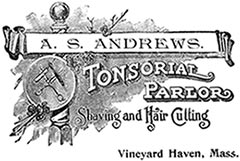Menu
A brief history of barbering - Blood, bandages and barber poles
Barbering is becoming increasingly popular with retro revival, the growing popularity of the beard, and a wide variety of haircuts on offer for men. But have you ever wondered what barbershops were actually like years ago, or even where the barber pole came from?
There are several different interpretations for the colours of the barber pole; most of them surrounding the subject of blood. Why blood I hear you ask? Historically, barbers used to be dentists and surgeons, well practiced in the art of bloodletting (an ancient system of medicine in which blood would be withdrawn from the patient’s body to prevent illness and disease). Yuk! This happened from 1096 up until as late as 1745 when George II passed several acts to separate surgeons from barbers.

By the end of the 18th Century, most barbers had given up their rights to perform surgery, except in small towns where surgeons were not available. They lost their status and became labourers, fashioning wigs in the 18th and 19th Century, while their shops became shady hangouts. If barbers had once been popular for being administers of therapeutic medicine, they were certainly made unpopular by the appearance of Sweeney Todd. It looked like the end of the barber profession.
However, the art of barbering was revived in 1893 when AB Moler established a school for barbers in Chicago. Barbers began to thrive again during World War II, when short hair was the trend, and in 1959 Edmond Roffler developed the Roffler Sculptur-Kut technique, which now has over 6,000 followers.
Today’s barbers combine traditional craftsmanship with cutting-edge tools. Having the right barbering supplies is essential for delivering precision cuts and maintaining the high standards the trade is known for. With the rise of dedicated barbering courses, today’s professionals can refine their skills, learn contemporary techniques, and continue the long-standing tradition of excellence that defines the trade.
So where does the barber pole come into it?
The history of the barber pole is intertwined with the history of barbers and their bloodletting practices. Patients would grasp a rod or staff tightly so that their veins would show, and the barbers would cut open their arms and bleed them until they fainted (nasty but true). Later, when leech therapy became popular, as they allowed for more controlled bleeding, the leeches were applied directly to the vein areas. After the procedure, the washed bandages were hung outside on a pole to dry, and to advertise the ghastly therapeutic specialities offered in the barbershop. Flapping in the wind, the long strips of bandages would twist around the pole in the spiral pattern we now associate with barbers.

This early barber pole was simply a wooden post topped by a brass leech basin. One source speculates that the poles were painted red to mask the bloodstains. Later, the basin was replaced by a ball and painted poles of red and white spirals took the place of the less tasteful pole with the bloodstained bandages, and these poles became permanent outdoor fixtures. After the formation of the United Barber Surgeon's Company in England, barbers were required to display blue and white poles, and surgeons, red ones. In America, however, the barber poles were painted red, white and blue to reflect the colours of the American flag.
To sum up, there are a few speculations as to the colours of the barber pole. One is that red represented blood and white the bandages. Another interpretation is that red and blue respectively stood for arterial and venous blood, and white was still for the bandages. A third suggests that the spiral pattern represents a white bandage wrapped around a bloody arm. The ball, of course, represents the basin of leeches as well as the blood-collection bowl.
Today's barbers more commonly use the updated combination of blue, white and red striped poles as an emblem of their profession. Thankfully, they no longer cut people's arms, by the way.










